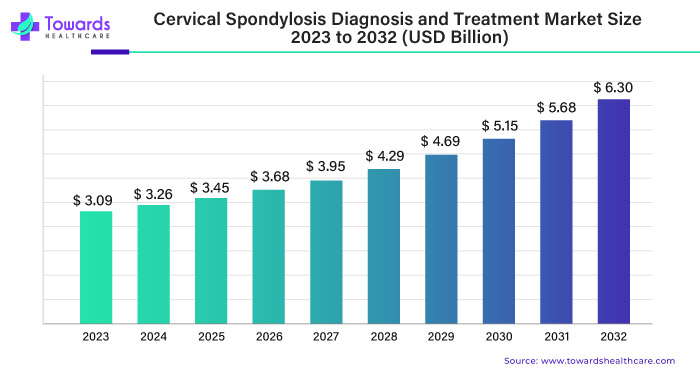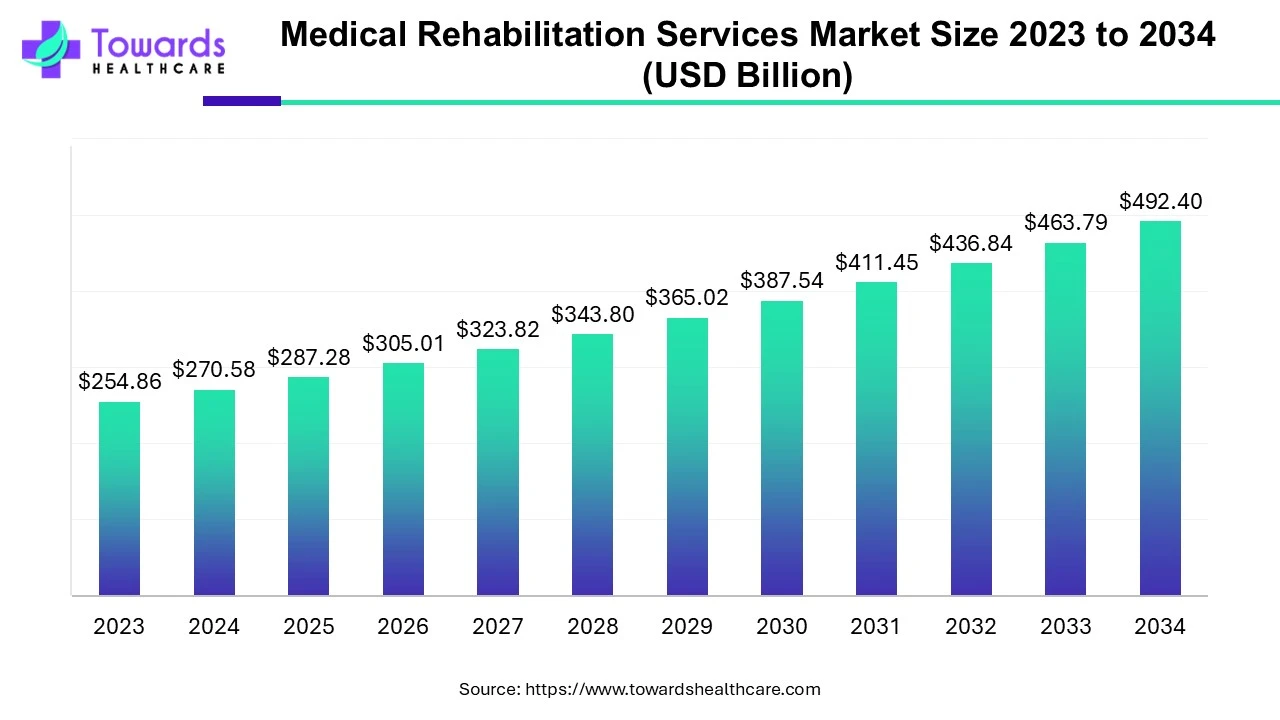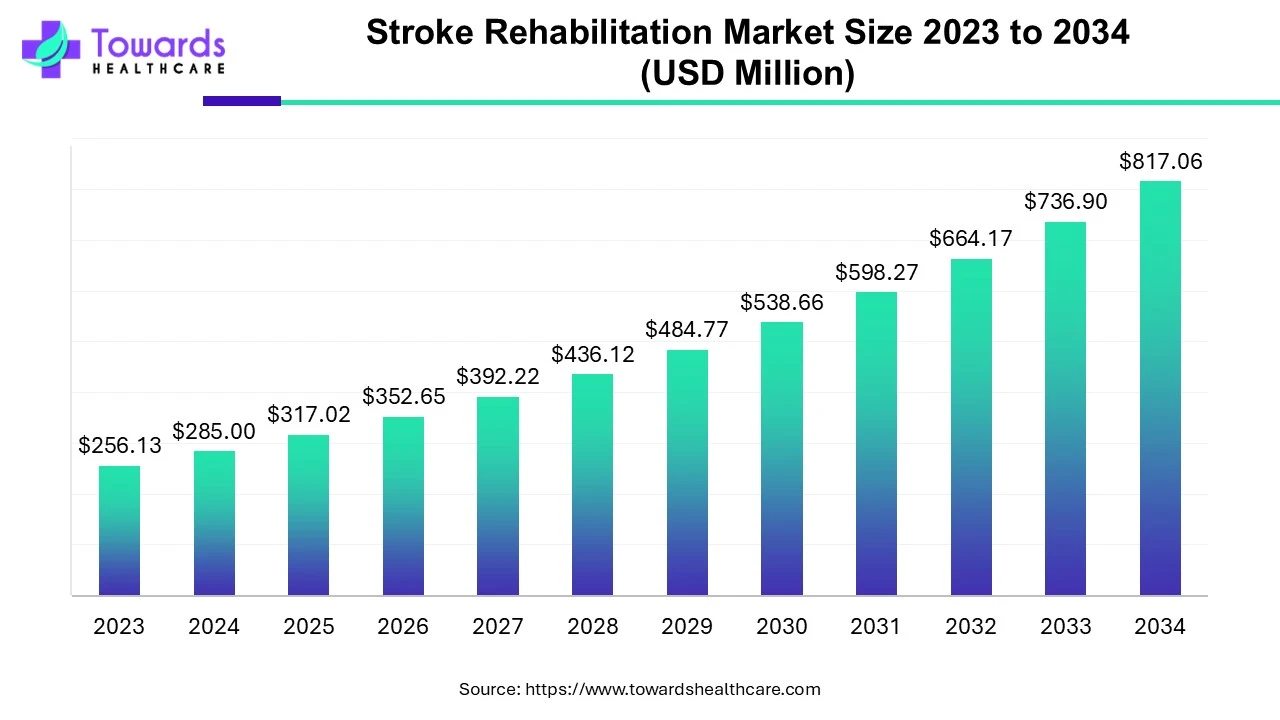Exploring the Growth of the Cervical Spondylosis Diagnosis and Treatment Market
The cervical spondylosis diagnosis and treatment market is projected to increase from approximately USD 6.21 billion in 2023 to around USD 11.83 billion by 2032, reflecting a compound annual growth rate (CAGR) of 6.7% from 2024 to 2032.

Download statistics of this report @ https://www.towardshealthcare.com/download-statistics/5134
Report Highlights:
- Medications dominated the market with a 38% market share.
- Hospital pharmacies lead the charge in 2023 with 40% market share.
- Asia Pacific accounted for a significant 35% market share.
The Growing Impact of Aging on Cervical Spondylosis: Challenges and Advances
As people age, their bodies undergo various changes, one of which is the wear and tear of the bones and cartilage in the neck, commonly known as cervical spondylosis. This condition becomes increasingly likely as individuals grow older due to the natural weakening of bones and tissues. Consequently, the discs between the vertebrae in the neck may begin to thin, losing their ability to absorb shock. This degeneration can lead to pain, stiffness, and discomfort in the neck.
For instance, cervical spondylosis is highly prevalent among the elderly, with over 85% of individuals aged 60 and above experiencing this condition. As global populations age, there is a rising demand for the diagnosis and treatment of cervical spondylosis. Older adults are more susceptible to symptoms due to the natural aging process, as the risk factors associated with prolonged wear and tear on the spine become more pronounced.
Furthermore, older adults often face additional age-related health issues that can exacerbate the symptoms of cervical spondylosis or complicate treatment. Conditions like osteoporosis, which weakens bones, can make the spine more vulnerable to degenerative changes. Given the increased risk of cervical spondylosis among older adults and its potential impact on their quality of life, there is a growing need for healthcare services that can accurately diagnose and effectively treat the condition. Healthcare providers may recommend various treatment options, including pain management techniques, physical therapy, and, in some cases, surgical interventions, to alleviate symptoms and improve mobility in older adults affected by cervical spondylosis.
As the population ages, the prevalence of cervical spondylosis is expected to rise, emphasizing the need for accessible and effective diagnosis and treatment options tailored to the specific needs of older adults.
Advances in Imaging Techniques Enhance Cervical Spondylosis Diagnosis
Recent advancements in diagnostic imaging, such as MRI and CT scans, have significantly improved doctors’ abilities to detect and treat conditions like cervical spondylosis. MRI utilizes strong magnets and radio waves to create detailed internal images, while CT scans employ X-rays to produce clear images from various angles.
These advanced imaging techniques have greatly enhanced the accuracy of cervical spondylosis diagnosis. They enable doctors to visualize the bones, discs, nerves, and soft tissues in the neck clearly, allowing for precise identification of any issues or damage. With these clearer images, healthcare providers can develop more effective treatment plans, better understand the extent of the condition, and tailor treatments to each patient’s unique needs. For example, they can determine if there is nerve compression in the neck and devise strategies to alleviate that pressure, thereby reducing pain and other symptoms.
A study conducted in April 2023 by researchers from Guangxi Normal University, China, explored various therapies, including Sling Exercises Training (SET), fascia manipulation, Muscle Energy Technique (MET), Proprioceptive Neuromuscular Facilitation (PNF), and virtual reality (VR) technology for cervical spondylosis rehabilitation. The findings suggested that integrating VR technology with these innovative therapies could enhance pain management strategies.
These imaging techniques are also instrumental in monitoring treatment efficacy over time. By comparing images from different time points, doctors can assess whether there has been improvement or deterioration in the condition, allowing for timely adjustments to treatment plans. MRI and CT scans have revolutionized the diagnosis and management of cervical spondylosis, providing invaluable tools to help patients manage their conditions more effectively and enhance their quality of life.
Innovations in Surgical Instruments: Spinal Implants
Cervical spondylosis occurs when the discs and bones in the neck deteriorate, leading to pain and stiffness. The development of advanced surgical tools, such as spinal implants, has significantly improved treatment outcomes. These implants support the spine and relieve pressure on nerves, allowing surgeons to perform more precise procedures, enhancing safety and reducing recovery times.
Recent News
In October 2023, Amber Implants launched the first-ever human trial for their VCFix spinal system, designed to address vertebral compression fractures. This trial marks a significant milestone in developing innovative medical technologies aimed at enhancing treatment options for patients with such fractures.
These advancements have contributed to significant growth in the cervical spondylosis diagnosis and treatment market. Patients benefit from improved surgical options, resulting in reduced pain and enhanced mobility. The market expansion is also fueled by increased awareness and diagnosis of cervical spondylosis globally. With ongoing research and innovation, the field continues to evolve, offering hope for better outcomes in the future.
The Challenge of Recognizing Cervical Spondylosis Symptoms
Many individuals lack awareness about cervical spondylosis, often failing to recognize the symptoms or appreciate the seriousness of the condition. This lack of understanding can lead to delayed diagnosis and treatment, as individuals might ignore symptoms such as neck pain and stiffness or rely on over-the-counter medications instead of consulting a healthcare professional. Such delays can result in the condition worsening over time, making management more challenging and potentially leading to further complications.
If people remain unaware of cervical spondylosis, they might only realize they have it when it becomes too late for prompt treatment. Therefore, raising awareness about the condition is crucial so individuals can recognize symptoms and seek medical assistance sooner.
Geographical Landscape of Cervical Spondylosis Diagnosis and Treatment
The landscape for diagnosing and treating cervical spondylosis is quite advanced in North America, with major cities like New York, Los Angeles, and Toronto hosting specialized medical centers equipped with cutting-edge technology and skilled healthcare professionals focused on spinal conditions. Urban residents generally have better access to these facilities; however, rural or remote areas may face challenges due to fewer specialized doctors and medical facilities, complicating the diagnosis and treatment of cervical spondylosis. Additionally, insurance coverage can significantly affect the types of treatments available and the out-of-pocket costs for patients in the United States.
In the Asia Pacific region, the landscape for cervical spondylosis diagnosis and treatment varies considerably by country. While some areas are seeing increased diagnosis rates due to growing awareness, others still struggle with low awareness levels, leading to underdiagnosis and undertreatment. Cultural factors and healthcare practices also influence the market.
For instance, according to Vaidam Health, a medical travel assistance company, the cost of treating cervical spondylosis in India ranges from Rs. 444,000 to Rs. 592,000 for domestic patients, while international patients can expect to pay between US$9,000 and US$11,000. Patients typically remain hospitalized for five days, with a total recovery time of around ten days, depending on their diagnosis and chosen facilities. Many patients in Asia Pacific still prefer alternative treatments over conventional medical interventions, which can affect the overall approach to managing cervical spondylosis. Furthermore, regulatory environments differ across countries, influencing the availability and affordability of medicines, with some regions facing barriers that hinder the introduction of new technologies and therapies.
Competitive Landscape of Cervical Spondylosis Diagnosis and Treatment
The competitive landscape for diagnosing and treating cervical spondylosis involves a diverse array of healthcare providers and medical device manufacturers. Companies producing diagnostic imaging equipment, such as X-ray machines, CT scanners, and MRI machines, play a crucial role in diagnosing cervical spondylosis. Manufacturers of spinal implants and devices used in surgical procedures for cervical spondylosis treatment are also significant players in the market, alongside pharmaceutical firms that develop medications for pain management, inflammation reduction, and other symptoms associated with the condition.
Recent Developments
In August 2023, ZimVie Inc., a US-based life sciences company specializing in dental and spine markets, expanded its partnership with Brainlab, a German leader in spine imaging and navigation solutions. This collaboration aims to integrate robotic imaging, surgical assistance, and mixed reality technologies to enhance the precision and safety of spinal surgeries.
In March 2021, Sleepsia, a US-based company known for its innovative pillows, introduced a specialized cervical pillow designed to alleviate symptoms associated with cervical spondylosis.
Cervical Spondylosis Diagnosis & Treatment Market Companies
- Novartis AG
- Merck & Co. Inc.
- Bayer AG
- Abbott
- Ortho Bracing
- Medtronic
- Stryker Corporation
- B. Braun Medical Ltd.
- DJO, LLC
- Aspen Medical Products, LLC
Cervical Spondylosis Diagnosis & Treatment Market Segments
By Diagnosis
- Imaging Tests
- Neck X-ray
- MRI
- CT Myelography
- Nerve Function Tests
- Electromyography
- Nerve Conduction Study
By Product Type
- Medications
- Non-steroidal Anti Inflammatory Drugs
- Muscle Relaxants
- Antidepressants
- Pain Relievers
- Medical Devices
- Cervical Collars
- Neck Traction Devices
- TENS Units
- Cervical Pillows
- Surgical Instruments
- Spinal Implants
- Other Surgical Instruments
By Distribution Channel
- Hospital Pharmacies
- Retail Pharmacies
- Online Pharmacies
By Geography
- North America
- Europe
- Asia Pacific
- Middle East and Africa
- South America
Discover our detailed Table of Contents (TOC) for the Industry, providing a thorough examination of market segments, material, emerging technologies and key trends. Our TOC offers a structured analysis of market dynamics, emerging innovations, and regional dynamics to guide your strategic decisions in this rapidly evolving healthcare field – https://www.towardshealthcare.com/table-of-content/cervical-spondylosis-diagnosis-and-treatment-market-sizing
To own our research study instantly, Click here @ https://www.towardshealthcare.com/price/5134
You can place an order or ask any questions, please feel free to contact us at sales@towardshealthcare.com
About Us
Towards Healthcare is a leading global provider of technological solutions, clinical research services, and advanced analytics to the healthcare sector, committed to forming creative connections that result in actionable insights and creative innovations. We are a global strategy consulting firm that assists business leaders in gaining a competitive edge and accelerating growth. We are a provider of technological solutions, clinical research services, and advanced analytics to the healthcare sector, committed to forming creative connections that result in actionable insights and creative innovations.
Visit Dental Specifics: https://www.towardsdental.com
Explore the comprehensive statistics and insights on healthcare industry data and its associated segmentation: Get a Subscription
For Latest Update Follow Us: https://www.linkedin.com/company/towards-healthcare


